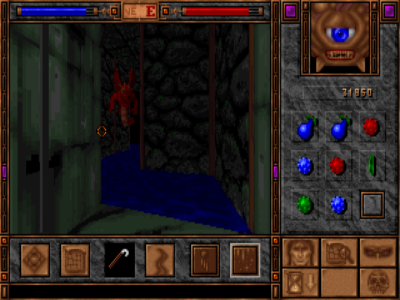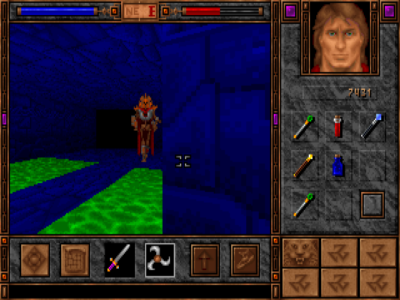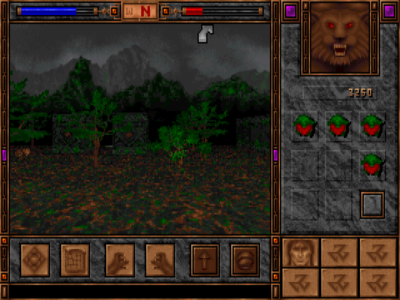
Shadowcaster
Written by: Stoo
Date posted: June 16, 2013
- Genre: Action
- Developed by: Raven Software
- Published by: Origin Systems
- Year released: 1993
- Our score: 6
My experience of Raven Software’s output is mostly their first person shooters; they released a bunch of decent games based on iD engines. For example I quite enjoyed the Quake 3 powered Voyager: Elite Force, and going further back they gave us the Doom-powered Heretic and Hexen. Today we’re looking at their very first entry into the world of first-person action, back in the early days of such things. It’s not quite a shooter though, with more of a fantasy angle and a few RPG elements mixed in. Also mullets.
I’m going to have to make a confession at this point – my savegame file got corrupted somehow about two thirds of the way through and I couldn’t face several hours replaying to reach that point again. Take that as a lesson, always have multiple saves! I think I’ve seen enough to write about my experience, but do let me know if I missed anything important. After all we have now joined the internet of, er, 10 years ago with a comments system.
Shadowcaster kicks off with an intro outlining the story which… is something about a guy learning he’s the last in a race of shapeshifters in a parallel world where war is raging. It’ll have to admit I’ve already forgotten if there’s anything more to it. Honestly, it doesn’t have much presence within the game. Still, the intro does have some pretty good VGA artwork and adlib music, which is something I always had a soft spot for. I believe there was also a CD version with that bane of the mid-90s, plastic-looking pre-rendered 3d animations. As ever, I say decently drawn 2D art from those days has aged a lot better.
The game itself is powered by a modified version of the engine used for id’s software’s early shooter, Wolfenstein 3D. A lot of the same limitations apply, so, levels are all still completely flat, with walls at right angles as if drawn on a big grid. However ceiling heights can vary between levels (although not within) and there is now some concept of vertical motion, and sometimes a lava pool or obstacle to hop over. There’s also a neat way of faking underwater sections – when you dive under the surface, the engine just loads another blue-tinted map with free vertical motion enabled.
Most levels have some sort of dungeon-ish stone walled theme, but do manage enough variety such that I wouldn’t call the game drab. You have mines, cold blue halls and then more finely decorated areas, like some kind of ancient palace. Also, it manages to take the “roof” off in a few maps, for a swampy beginning, and a later on a big graveyard area. The basic rendering of its world means maps can still become samey after a while, so it would be easy to get lost, but fortunately an auto-map is included.
Your character starts off as a very 90s sort of hero, with a winning combo of mullet, jacket and jeans. At first, he’s limited to tackling enemies with some sort of unimpressive karate chop. Before too long you pick up some weapons in the form of swords and magic wands with which to fight more effectively. More importantly tho, you’re quickly introduced to the game’s signature feature, which is shapeshifting. You pick up various new physical forms to take on, and can shift between them at will.
Your first form is some kind of cat-monster. Hunch-backed and four armed, he looks a bit tortured and angry, and dangling a string playfully in front of him would probably go badly. His enhanced physical strength is however very useful in melee combat. The next is a little pixie-like guy who’s not great in a direct fight, but offers a bunch of useful utility and healing spells. Then you get a floating-eye-beast that goes on the offensive with spellcasting, with a couple of fireballs and another spell to try and outright kill a target. Its weakness is again being rubbish in a melee fight. Next up is a frog-man who’s essential to underwater maps. Then a couple more.
Most forms will consume your magic reserves with their abilities, forcing you to sometimes revert to mullet-man, as he’s the only one who can recharge mana. The rate of recharging is awfully slow, and since mana-potions are relatively rare, I often found myself leaving him standing in a quiet corner while I did something else for ten minutes. That aside, the shapeshifting is I think quite a neat feature. Not every form is equally useful – I never spent long in pixie-mode – but each contributes at least something to your efforts and is quite clearly distinct in its capabilities.
The controls use keys for movement along with a mouse-pointer, as opposed to mouse-look as we know it today. The pointer aims ranged weapons, or you can click in various parts of your view as an alternate way to move. Not that you’d want to as it’s a fairly clumsy way to control movement. Unfortunately, it seems to be the *only* way to side-step. What’s more, sideways motion is really slow. This can be kind of annoying in combat, particularly against ranged foes, as Doom-style circle-strafing is basically impossible. To make up for that, for ranged battles I tried to take advantage of not having to fire in the direction I was moving. So I’d kinda leap out then move backwards diagonally into cover whilst firing off to my side.
Here’s another oddity, in that enemies make no noises until they’re attacking. Which means you sometimes might have no idea they’re there until you suddenly hear your own “in pain” grunt and see your health going down. Okay sure, I could pay more attention to my surroundings, but you wouldn’t expect a giant boar-monster to base its tactics on stealth. I think it’s fair enough to be critical on this point, since Wolfenstein had already established that baddies could yell GESTAPO to give us a bit of warning.
Anyway the game is mostly just about killing you way through levels, in a straightforward manner. You do need to explore fairly thoroughly though, to make sure you pick up plot items required to progress. There is a bit of interacting with the environment sometimes, and some puzzle solving. For example, those seeds dropped by monsters in the first map do have a use. You’ll also find yourself backtracking across maps already covered, once in a while, as new ways forward are opened up.
One more feature to discuss, as I mentioned this having RPG elements. As you kill stuff you accumulate experience points, which leads to levelling up. What exactly this means in practise, I’m not totally sure, the game just says “you feel a surge of strength and power” and I’m pretty sure a hit point boost follows. I’m guessing maybe strength and mana too. Each of your shape-shifting forms levels independently, which at least encourages you to try and kill something with that pixie (hack furiously at their ankles!) to power him up a bit.

The eye-beast can pummel foes from afar with spells, but magic reserves take a long time to recharge.
There’s not a lot more depth or detail to Shadowcaster’s RPG side, and for the sake of having to fit games under one genre I went with action. (if I try changing how we structure the site now, Rik will have me shot). Still, considering also the slower pacing, the interface and the magic spells, the comparison that springs to mind for me isn’t so much “fantasy Wolfenstein”, but rather a simplified cousin of Ultima Underworld. Which was itself single-character RPG that pioneered use of smooth-scrolling 3D engines. Shadowcaster’s shapeshifting can then be see as switching between traditional character classes on the fly – cat-man is a warrior, Pixie is a priest and so on.
So that’s another trip to the early 90s wrapped up. My playthrough of Shadowcaster was a bit frustrating at times, mostly when I was wondering if I’d missed some trick for mana regeneration. Still, it the shapeshifting concept lifts it from what would be quite a forgettable title into something more unique. I think it is, while not a major event in the history of first person gaming, an interesting little divergence. Raven never did a sequel and it’s very much lapsed into obscurity over the years. So I hope someone one day takes the concept and gives it a modern update.




 Posts
Posts
I couldn’t agree more concerning the irritation about recharging mana. I, too, never found another workable way than standing around in a safe corner forever.
When I last played this game, I was really taken aback how badly the graphics had aged. When it was new, I was very impressed with the fluid movements even on a fairly slow computer and in spite of all the detailed textures. Nowadays… it’s exactly those textures which just didn’t appeal to me anymore. They look exactly like what they are: two-dimensional wallpapers tacked on the plain objects. There is little or no sense of perspective. Also, objects and characters in the scenes (read: trees and skeletons) have no depth. They’re just flat bitmaps which can be seen from exactly four sides, but which nevertheless never ‘act’ differently.
Nevertheless, once I got over this light shock of my memories being so clearly misleading, I did find it quite playable. They key here being the comfortable automapping, the moderate difficulty level and the absence of my pet peeve of such games: The inability to carry *everything* you find around with you.
June 19, 2013 @ 8:26 pm